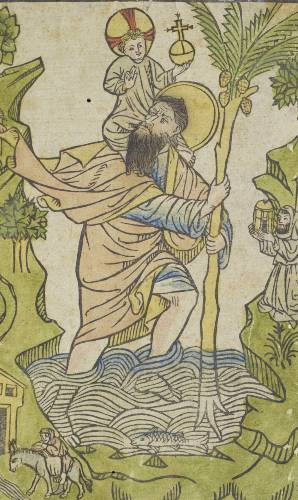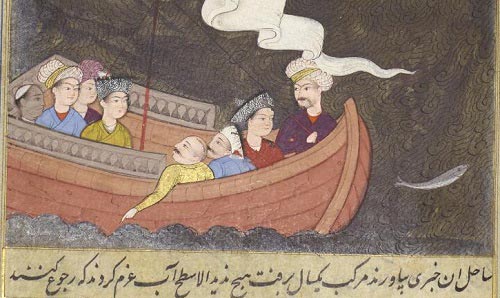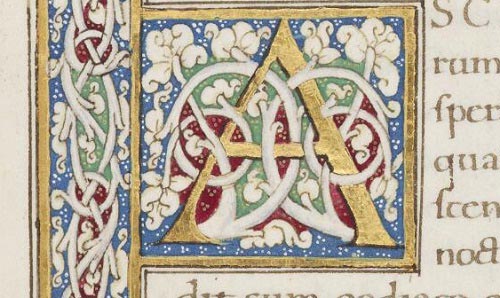
History of the Book Collections
The collections provide a significant resource for the study of many forms of communications: written, visual and print.

These include some of the most important primary sources in Europe, with enormous research potential across an array of subjects. Rare books range from the pinnacles of European printing, such as Gutenberg and Caxton, to examples of street literature and seditious texts. Manuscripts span four thousand years and over fifty languages, and are written on virtually every medium ever employed, including: clay, papyrus, parchment, vellum, linen, palm leaves, copper, ivory, felt, silk, bark and bamboo.
We encourage the use of these collections in teaching and research, especially to investigate the history of the book throughout the medieval and early modern periods, including its classical and late antique antecedents, and the late medieval and early modern transformation into print. While the collections encompass astonishing variety, there are some particular strengths to note.
The ancient world
The library has over 1000 cuneiform tablets, one of the earliest writing systems. Most of the Rylands tablets come from the great temples of Drehem and Umma and date from the Ur III dynasty (22nd–21st centuries BCE), but there are also First Babylonian Dynasty fragments (20th–17th centuries BCE) and later Babylonian and Assyrian pieces. There are several thousand fragments of papyri, dating from the 3rd century BCE to 7th century CE, mostly in Greek, Coptic and Arabic. They include many significant early witnesses to classical, biblical and medical texts as well as business papers, public records and correspondence. There is also a collection of over 11,000 fragments in Hebrew, Aramaic, Judaeo-Arabic and other Jewish languages from the Genizah (storehouse) of the Ben Ezra Synagogue in Old Cairo (Fustat).
Manuscripts
Manuscripts include material produced before the development of printing technologies, but also after, as handwriting remained important for communication and the reproduction of text. Manuscripts appear in numerous physical formats, including but not limited to tablets, scrolls, rolls and in book form (often referred to as a codex). Our manuscript collections are generally organised by language. We have particular strengths in the following areas: Ancient texts, Book art, Hebraica, Medieval and Early Modern texts, Middle Eastern manuscripts, and Modern European manuscripts. Many of these are part of the manuscript collections of the 25th and 26th Earls of Crawford, which were purchased by Enriqueta Rylands in 1901.
The rise of print
Our Western printed books range from incunables, the earliest European books to be printed using moveable metal type, to modern, machine-made publications. Broad fields of human knowledge and experience are captured within their pages, in hundreds of different languages and dialects. But rare books offer more than just content. The book-as-object; materiality; manufacture and distribution; social and historical context; provenance, ownership and use; these are all areas of potential study. A concise conspectus of early printing is afforded by the Hiero von Holtorp Collection, which contains specimen leaves from virtually all 15th- and 16th-century printers in Germany, Italy, France, Spain, the Netherlands and England. For the 16th century, the Library's greatest strengths lie in the field of Italian printing. The largest Aldine Collection in the world contains virtually every work produced by Aldus Manutius and his Venetian successors between 1495 and 1598, while the Bullock Collection holds an even wider range of Italian writers.
The East Asian collections include about 700 volumes from China and 230 Japanese printed books. This represents five centuries of East Asian culture and includes histories; geographical works and narratives of travels; biographies; ceremonials; dictionaries; encyclopaedias; botanical and medical treatises; grammar books; compendia of poetry and prose literature; and works on calligraphy.
Bindings
From medieval to modern, the collections encompass a broad array of fine bindings from England, Europe, the Middle East and beyond. Our manuscript collections, from all geographic areas, include many examples of original bindings – from jewelled book covers, ivory carvings, gilt and painted decoration to plainer, more practical constructions. European bindings from the fifteenth to the nineteenth centuries are found in collections such as Spencer, Christie and Lloyd Roberts. Examples include bindings from the libraries of individuals, families and institutions, including royalty, aristocrats, religious houses and educational establishments, and bindings by celebrated craftsmen such as Roger Payne, the greatest English binder of the 18th century; the Library holds the largest extant collection of bindings by Payne as well as a collection of his bills (English MSS 440 and 944). A selection of single and double fore-edge paintings is also available.
Historic western bindings sit alongside later innovations, including mass-produced publishers’ cloth bindings, and modern designer bookbindings. Fine bindings, including work by several women bookbinders, are found in our Tregaskis Bindings collections (1894 and 1994), which showcase bindings from around the world. The Anthony Dowd Bindings collection focusses on 20th-century British designer bookbinders. Our Private Press collection includes examples of work by bookbinders of the Arts and Crafts movement, such as Douglas Cockerell and Katherine Adams.
There are also a number of different traditional book forms in East Asia including scrolls, concertina folded books and the more familiar codex form. Usually the text is printed on only one side of the paper, the leaf is folded and the free edges sewn together. It is then covered with coloured paper or thicker card, sometimes with a printed title label and image. These forms have proved remarkably durable and are still in use today.
English provincial printing
Until the lapse of the Printing (Licensing) Act in 1695, printing in England was limited to London, Cambridge, Oxford and York. Thereafter, printing in provincial towns gradually became more widespread. Our collections include numerous examples of provincial printing from the 18th and 19th centuries, with a focus on Manchester and the north-west. Examples include John Jackson’s Mathematical Lectures (Manchester: Roger Adams, 1719), the first extant book to be printed in Manchester, known in only four copies, and A Catalogue of the Library of the Late Richard Mydleton Massey, M. D. (Leeds: James Lister, 1745), believed to be the earliest surviving printed catalogue of a book auction held in Manchester. A wide range of ephemeral ‘jobbing printing’, the bread-and-butter of many regional print shops, can be found in our Street Literature collection. By contrast, the Library also holds many imprints by John Baskerville (1707-1775) of Birmingham and William Eyres (1734-1803) of Warrington, who were renowned for the quality of their printing.
Periodicals and newspapers
Printed at intervals, from daily newspapers to annual yearbooks, periodicals can entertain, inform, and provide a collective voice for particular interest groups. Diverse in terms of date, subject, language and intended audience, our collections range from scholarly journals to popular magazines; from mainstream titles to underground ‘zines’.
Among our earliest holdings are newsbooks from the Civil War period, and Philosophical Transactions, the world’s earliest scientific journal, first published in 1665. 18th-century publications include The Gentleman’s Magazine, launched in 1731, the first periodical to use the term ‘magazine’ in its title. Radical periodicals from the 18th and 19th centuries include a full-run of the newspaper, the Manchester Observer (1818-1822) and Cotton Factory Times (1899-1937). A range of 19th-century illustrated periodicals and literary magazines is also available.
Our French Revolution collection contains over 1,000 contemporary periodicals and newspapers. Other collections with high periodical content include our Methodist, Christian Brethren and Railway Collections. Our Jack Cox collection includes an extensive run of the Boy's Own Paper.
Single-sheet publications
Items printed on one or both sides of a single sheet of paper range from 15th-century papal indulgences to private press ephemera, and modern-day posters, leaflets and fact-sheets. However, the majority of our single-sheet material consists of street literature dating from the 17th to 19th centuries. Sold by itinerant chapmen or posted in public places, most street literature was discarded soon after publication. However, surviving examples capture many aspects of daily life, from politics and religion, to entertainment and leisure. Our collections include: proclamations, public notices, advertisements, execution broadsides, election literature, horse-racing bills, and handbills. Our European Proclamations and Broadsides collection contains over 10,000 proclamations and broadsides, dating from c.1530 to 1890. The Library also holds over 1,000 broadside ballads and slip songs, and more than 900 playbills for London, provincial and travelling theatres.
Private press and fine printing
Fine printing in the 18th century is represented by the works of the greatest English and Italian printers of the period, John Baskerville and Giambattista Bodoni, and by the Glaswegian Foulis Press. The latter contains over 150 editions including a number of copies printed on silk and vellum. There are also works from Horace Walpole’s pioneering private press, the Strawberry Hill Press.
The Library’s Private Press collection includes outstanding holdings from the golden age of the English Private Press Movement in the 1890s. The Kelmscott, Doves, Ashendene and Essex House Presses are represented in complete or near-complete collections of major works, including some copies printed on vellum. Later presses include Dun Emer, Cuala, Vale, Eragny, Golden Cockerel, Shakespeare Head, Nonesuch, Gregynog, Stanbrook Abbey and Hayloft. Among modern presses, the Whittington Press, Fleece Press, and Oldham’s Incline Press are particularly well represented. Although the focus is on British and Irish presses, the collection spans eleven countries, including the United States; the Library is one of the few British institutions actively to collect the works of Russell Maret of New York. Major works are complemented by ephemera including announcements, prospectuses and specimen pages. Examples of 19th- and 20th-century private press and commercial fine print editions can also be found in the collections formed by Olga X. Casdagli and Allen Freer.
History of libraries and collecting
In addition to the foundational Spencer and Crawford collections, the Library holds numerous collections that constitute key resources for the histories of books and book collecting. The archive of the John Rylands Library is fundamentally important to studies of the formation and provenance of its own collections and of the history of libraries more generally.
Notable individual collections include: the outstanding collection of Richard Copley Christie, formed ‘with a view of illustrating and enabling its owner to study the Renaissance, and especially the classical Renaissance of Italy and France’; the Bullock Collection, illustrating the literature and social life of Renaissance Italy; the Tabley Book Collection, a fine country-house library from Tabley House in Cheshire; the library from Sedbergh School in Cumbria, a representative example of a public-school library and full of bibliographical interest; the Lloyd Roberts Collection, which contains numerous first editions of major English authors as well as fine bindings; and the Shackleton Collection, which is especially rich in 18th-century French and English publications. Important bookplate collections include the Tabley Muniments and the George H. Viner Bookplate Collection.
The Library also holds comprehensive collections of publications by several exclusive bibliographical societies founded in the 19th century, such as the Roxburghe Club and the Scottish Bannatyne and Maitland Club.
List of collections
Physical collections
- Aldine Collection
- Bannatyne Club and Maitland Club
- Baskerville Press
- Giambattista Bodoni Printed Works
- Bullock Collection
- Olga X. Casdagli Book Collection
- Chinese Collection
- Christian Brethren Archive
- Christie Collection
- Coptic Manuscripts
- Jack Cox Printed Collection
- Crawford Collection
- Cuneiform Tablets
- Anthony Dowd Bindings Collection
- Egyptian Manuscripts
- European Proclamations and Broadsides Collection
- Foulis Press
- Allen Freer Book Collection
- French Revolution Collection
- Rylands Cairo Genizah Collection
- Greek Manuscripts
- Hayloft Press Archive
- Hiero von Holtorp Collection
- Incunabula Collection
- Japanese Collection
- Lloyd Roberts Collection
- Methodist Printed Book and Periodical Collections
- Private Press Collection
- Railway Collections
- Roxburghe Club Collection
- John Rylands Library Archive
- Sedbergh School Library Collection
- Shackleton Collection
- Spencer Collection
- Stanbrook Abbey Press Collection
- Street Literature Collection
- Tabley Book Collection
- Tabley Muniments
- Tregaskis Bindings Collections
- George H. Viner Bookplate Collection
Digital collections
-
Broadside Ballads in Manchester Digital Collections
- Bible Illustrations in Manchester Digital Collections
- Dante in Manchester Digital Collections
- Magic, Monsters and Macabre in Manchester Digital Collections
- Papyrus to Print in Manchester Digital Collections
- Petrarch in Manchester Digital Collections
- Revolutionary France in Manchester Digital Collections
Further information
Related subject pages
- East Asia Collections
- Religion and Theology Collections
- Middle East Collections
- Western European Manuscript Collections
Rylands blog posts
- Steph Bushell, ‘The Private Press Collection at the John Rylands Library’.
- Steph Bushell, ‘The Private Press Collection: A Curator’s Perspective’.
- John Hodgson, ‘Zines & the Art of DIY Publishing’.
- Janette Martin, ‘A Closer Look at the Manchester Observer (1819–1822)’.
- Robert Mazza, ‘‘If your anus twitches, then troubles will follow…’ Human bodies, divination and papyrology ‘
- Niki Pantazidou, ‘Rehousing the Greek Papyri’
- Julie Ramwell, ‘New Digital Collection: Broadside Ballads’.
- Julianne Simpson, ‘New Digital Collection: Revolutionary France’.

Exploring subject areas
An overview of our Special Collections, including information about the background and history of our holdings.

Special Collections A-Z
Explore the Special Collections through the collection names and descriptions using our searchable A-Z tool.
